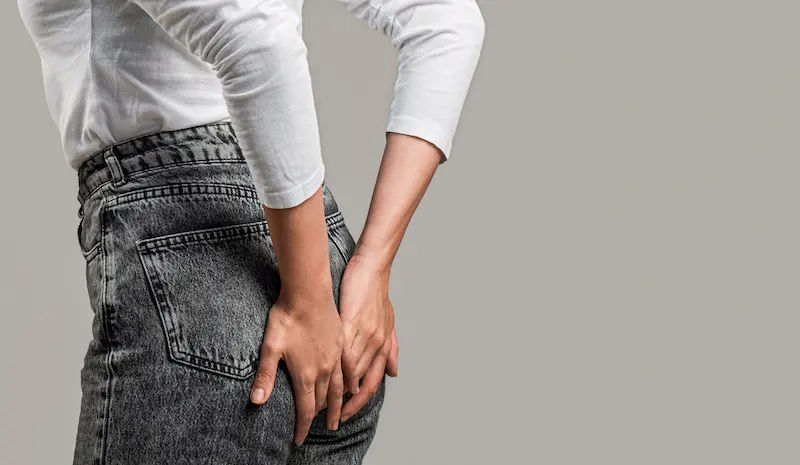Anal Fissure: Causes and Early Signs
Learn about the causes, early signs, and prevention of anal fissures to ensure timely treatment and better digestive health.

Written by Dr. Dhankecha Mayank Dineshbhai
Reviewed by Dr. Rohinipriyanka Pondugula MBBS
Last updated on 3rd Oct, 2025

Introduction
That sharp, searing pain during or after a bowel movement can be alarming. Many people suffer in silence, fearing the worst, but often the culprit is a common and treatable condition: an anal fissure. Think of it as a small paper cut, but in the delicate lining of your anus. While incredibly painful, understanding what leads to an anal fissure is the first step toward effective treatment and lasting relief. This article will demystify this condition, exploring everything from the primary causes and risk factors to the unmistakable signs. We’ll delve into why they occur, who is most at risk, and how you can distinguish them from other similar issues. By the end, you’ll have a clear roadmap for identifying, managing, and preventing this uncomfortable problem.
What Exactly is an Anal Fissure?
An anal fissure is a small tear or ulcer in the thin, moist tissue (mucosa) that lines the anus. The anus is the opening at the end of the digestive tract where stool exits the body. This tear exposes the underlying muscle, called the internal anal sphincter. When stool passes through the anus, it irritates this exposed muscle, causing significant pain and sometimes bleeding. It’s a classic case of a small problem causing a large amount of discomfort.
Acute vs. Chronic Anal Fissures: What's the Difference?
Understanding this distinction is crucial for treatment.
- Acute Anal Fissures: These are recent tears, similar to a cut that hasn't had time to heal. They typically respond well to conservative treatments like dietary changes and warm baths. Most acute fissures heal within a few weeks.
- Chronic Anal Fissures: If a fissure persists for more than 8 weeks, it is considered chronic. These fissures often have a cyclical nature of healing and re-tearing. They may develop extra tissue at the edges (a sentinel pile or skin tag) or expose the underlying internal sphincter muscle, which can lead to increased spasms and pain, creating a vicious cycle that prevents healing.
The Primary Culprit: What Directly Causes an Anal Fissure?
The vast majority of anal fissures are caused by trauma to the anal canal. The most common source of this trauma is the passage of hard, dry, or large stools. Constipation forces you to strain during bowel movements, which can overstretch the anal lining, causing it to tear.
However, it’s not always about constipation. Surprisingly, frequent episodes of diarrhoea can also irritate and weaken the anal lining, making it susceptible to tearing. Other direct causes include:
- Childbirth: The strain and pressure during vaginal delivery can cause fissures in new mothers.
- Anal Intercourse: This can sometimes lead to fissures if not done with adequate care and lubrication.
- Foreign Body Insertion: In rare cases, the insertion of an object can cause a tear.
Essentially, any event that causes the anal canal to stretch beyond its normal capacity can result in a fissure.
Consult a Colorectal Surgeon for the best advice
Beyond the Tear: Key Risk Factors That Increase Your Odds
While the direct cause is often physical trauma, several factors can predispose you to developing an anal fissure.
Dietary and Lifestyle Factors
A low-fibre diet is the single biggest risk factor. Fibre adds bulk and softens stool, making it easier to pass without straining. Dehydration compounds this problem, as water is essential for keeping stool soft. A sedentary lifestyle can also contribute to sluggish bowel function.
Underlying Medical Conditions
Certain health issues can increase susceptibility. Inflammatory Bowel Diseases (IBD) like Crohn's disease can cause chronic inflammation and ulceration in the anal area. Some sexually transmitted infections (STIs) that affect the anorectal region can also mimic or cause fissures. In older adults, decreased blood flow to the anorectal area can impair healing.
Physiological and Age-Related Factors
Anal fissures can affect anyone, but they are particularly common in two groups:
- Infants: The reason isn't entirely clear, but they are common in babies.
- Middle-Aged Adults: This group often experiences changes in bowel habits and may be more prone to constipation.
A key physiological factor is anal sphincter hypertonia, an abnormally high resting pressure in the internal anal sphincter. This reduces blood flow to the posterior part of the anal canal (where most fissures occur), creating an "ischaemic" environment that hinders healing. This is a critical insight often missed in basic explanations and is a primary target for certain medical treatments.
Recognising the Signs: Common Symptoms of an Anal Fissure
The symptoms of an anal fissure are usually distinct and hard to ignore.
The Hallmark Symptom: Anal Pain
The pain is typically sharp, severe, and tearing or burning in nature. It occurs during and especially after a bowel movement. This post-defecation pain can last from several minutes to a few hours. The pain is caused by the stool stretching the tear and the subsequent spasm of the internal anal sphincter.
Visible Signs: Bright Red Blood
You may notice bright red blood on the toilet paper or on the surface of the stool or in the toilet bowl. The bleeding is usually light because the tear is superficial. Heavy bleeding is not typical of a simple fissure and should prompt immediate medical attention.
Other Tell-tale Indicators
- A Visible Tear: Sometimes, you might see a small skin separation if you gently separate the buttocks.
- A Skin Tag: Near the anus (a sentinel pile), which can develop with chronic fissures.
Itching or Irritation: (Pruritus Ani) in the anal region.
Many people wonder about the difference between a fissure and hemorrhoids. While both can cause pain and bleeding, the pain from a fissure is typically more sharp and directly related to bowel movements. Haemorrhoid pain is often more of a dull ache or feeling of fullness, and bleeding may be more prominent.
How Are Anal Fissures Diagnosed?
A doctor can often diagnose an anal fissure simply by discussing your symptoms. A visual inspection of the anal region is usually sufficient to confirm it. The doctor will gently part the buttocks to look for the tear, which is most commonly located in the midline (posteriorly). Because the examination can be painful, the doctor will be as gentle as possible and usually will not need to perform an internal exam (like a digital rectal exam) initially if a classic fissure is visible. If your symptoms are atypical or suggest another condition, further evaluation may be needed.
A Roadmap to Relief: Treatment Options for Anal Fissures
Treatment depends on whether the fissure is acute or chronic.
First-Line Defences: Conservative and Home Treatments
For acute fissures, these methods are highly effective:
- High-Fibre Diet and Hydration: Aim for 25-35 grams of fibre daily from fruits, vegetables, and whole grains. Drink plenty of water.
- Sitz Baths: Soaking the anal area in warm water for 10-15 minutes, 2-3 times a day, especially after bowel movements, can relax the sphincter muscle and promote blood flow.
- Stool Softeners: Over-the-counter options can help prevent hard stools while you increase your fibre intake.
When to Seek Medical Help: Pharmacological Treatments
If conservative measures fail, a doctor may prescribe:
- Topical Muscle Relaxants: Such as nitroglycerin or nifedipine ointment, which relax the sphincter to increase blood flow and promote healing.
- Botulinum Toxin (Botox) Injections: This temporarily paralyses the sphincter muscle, relieving spasms.
Surgical Interventions for Chronic Fissures
When all else fails, a minor procedure called Lateral Internal Sphincterotomy (LIS) is considered the gold standard. It involves making a small cut in the sphincter muscle to permanently reduce its resting pressure, allowing the fissure to heal.
Prevention is Key: How to Stop a Fissure Before It Starts
The best treatment for an anal fissure is to prevent it from happening in the first place. The cornerstone of prevention is avoiding constipation and straining.
- Maintain a high-fibre diet.
- Stay well-hydrated.
- Exercise regularly to stimulate bowel function.
- Don’t ignore the urge to have a bowel movement.
- Avoid straining on the toilet.
Conclusion
An anal fissure, while painful and distressing, is a manageable condition. Understanding that it is most often a direct result of bowel trauma and heightened sphincter pressure empowers you to take proactive steps. By recognising the early signs of an anal fissure, such as characteristic sharp pain and minor bleeding, you can seek appropriate care sooner rather than later. The journey to healing almost always begins with simple lifestyle adjustments aimed at promoting soft, regular stools. Remember, if your pain is severe, bleeding is heavy, or your condition does not improve after trying conservative methods for a couple of weeks, it is essential to seek professional medical advice. There is no need to suffer in silence; effective solutions are available.
Consult a Colorectal Surgeon for the best advice
Consult a Colorectal Surgeon for the best advice

Dr. Chinnaya Parimi
Surgical Gastroenterologist
22 Years • MS, FACS
Hyderabad
Apollo Medical Centre Kondapur, Hyderabad

Dr. Sunil Kaul
General Surgeon
30 Years • MBBS, MS, FICS, FIMSA, FMAS
Delhi
Apollo Hospitals Indraprastha, Delhi
(25+ Patients)

Dr. Varughese Mathai
Colorectal Surgeon
28 Years • MBBS, M.S (Master of Surg.), DNB Surg.
Hyderabad
Apollo Hospitals Jubilee Hills, Hyderabad
(50+ Patients)

Dr Wasif Raza
General Surgeon
12 Years • MS (Gen Surgery),MCh (Colon & Rectal Surgery) , FRCS (UK), FACS (USA)
Lucknow
Apollomedics Super Speciality Hospital, Lucknow

Dr. Ramalinga Reddy
General Physician
5 Years • MBBS MD General medicine
Bengaluru
PRESTIGE SHANTHINIKETAN - SOCIETY CLINIC, Bengaluru
Consult a Colorectal Surgeon for the best advice

Dr. Chinnaya Parimi
Surgical Gastroenterologist
22 Years • MS, FACS
Hyderabad
Apollo Medical Centre Kondapur, Hyderabad

Dr. Sunil Kaul
General Surgeon
30 Years • MBBS, MS, FICS, FIMSA, FMAS
Delhi
Apollo Hospitals Indraprastha, Delhi
(25+ Patients)

Dr. Varughese Mathai
Colorectal Surgeon
28 Years • MBBS, M.S (Master of Surg.), DNB Surg.
Hyderabad
Apollo Hospitals Jubilee Hills, Hyderabad
(50+ Patients)

Dr Wasif Raza
General Surgeon
12 Years • MS (Gen Surgery),MCh (Colon & Rectal Surgery) , FRCS (UK), FACS (USA)
Lucknow
Apollomedics Super Speciality Hospital, Lucknow

Dr. Ramalinga Reddy
General Physician
5 Years • MBBS MD General medicine
Bengaluru
PRESTIGE SHANTHINIKETAN - SOCIETY CLINIC, Bengaluru
More articles from Anal fistula
Frequently Asked Questions
How long does it take for an anal fissure to heal?
Most acute anal fissures heal within 4 to 6 weeks with proper conservative treatment, such as increasing fibre and water intake and taking sitz baths. Chronic fissures that have been present for over 8 weeks may take longer and often require medical intervention.
Can I use haemorrhoid cream for an anal fissure?
While some haemorrhoid creams contain local anesthetics (like lidocaine) that can temporarily numb the pain, they do not address the underlying muscle spasm that prevents a fissure from healing. It's better to use treatments specifically designed to relax the sphincter, like those prescribed by a doctor.
What is the difference between a fissure and an abscess?
A fissure is a simple tear in the skin. An abscess is a collection of pus caused by an infection in an anal gland. An abscess typically causes a throbbing, constant pain, often accompanied by swelling, fever, and a general feeling of being unwell. The pain from a fissure is more directly tied to bowel movements.
Are anal fissures a sign of cancer?
Anal fissures are not typically a sign of cancer. They are usually benign conditions caused by trauma. However, any persistent sore or ulcer in the anal area should be evaluated by a doctor to rule out other, more serious conditions, especially if it's not healing with standard treatment.
Can anal fissures come back after healing?
Yes, recurrence is possible, especially if the underlying causes, like chronic constipation, are not addressed. The key to preventing recurrence is maintaining a high-fibre diet, drinking plenty of fluids, and avoiding straining during bowel movements.

